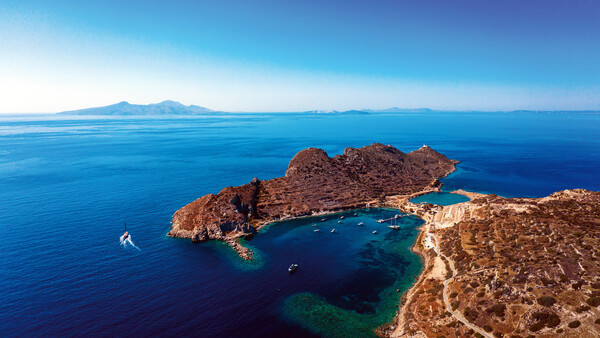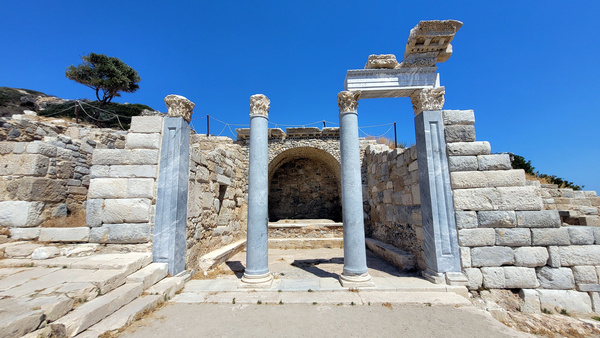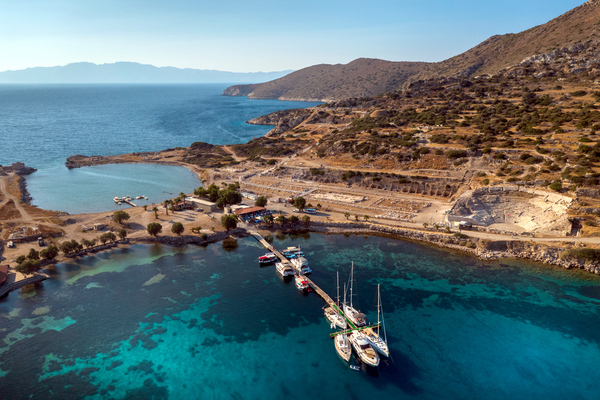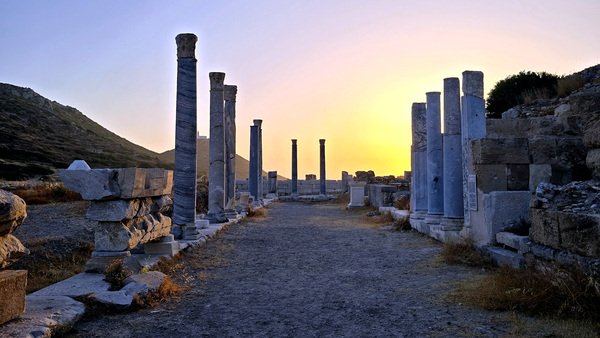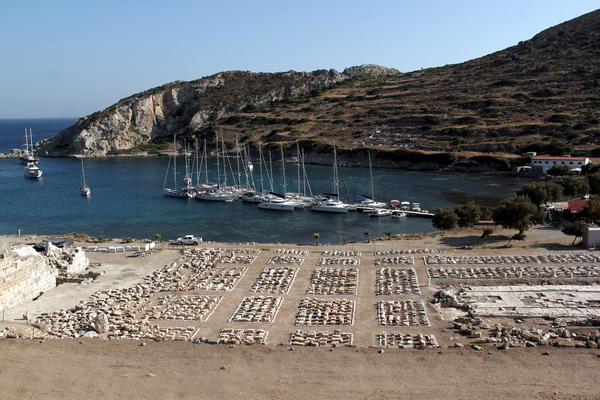Knidos sailing holidays
History
The remains of ancient Knidos (Cnidus) on the Carian coast – once famed as a centre of art and learning – lie at the western tip of a peninsula known in antiquity as the Cnidian Chersonese or Dorian Promontory which projects far into the Aegean and the Dodecanese.
The western tip of the Datça peninsula (Cape Krio • ancient Cape Triopion) falling steeply into the sea was originally an island, but in Classical times was already joined to the mainland by a narrow strip of land. Ancient Knidos was built on the island but later extended also onto the slopes of the hill on the mainland.
Knidos was founded probably in the 7th c. BCE by Laconians from the southeastern Peloponnese and rapidly developed into a place of some consequence as a result of its trading activities, its shipping and its crafts (e.g. pottery). By the 6th c. BCE it was already sending settlers to the Adriatic.
Note the Red and Green buoys which will guide you towards the jetty and anchorage. See Hi-res image
On Cape Triopion there stood a Temple of Apollo (not yet located), the shrine of the Hexapolis, a league of six Dorian cities whose other members were Kos, Halicarnassus, Lindos, Ialysos and Camiros (the last three on the island of Rhodes).
In 540 BCE Knidos submitted to the Persian General Harpagos. The city continued to flourish when it became part of the Athenian Empire. Like Kos, it had a famous medical school. Later it became a Spartan base, but was liberated by the Athenian General Konon, who in 394 BCE as commander of a Persian fleet destroyed Spartan sea-power in a naval battle fought off Knidos.
That art and learning continued to flourish in Knidos in the 4th c. BCE is demonstrated by the names of the great astronomer Eudoxos and the architect Sostratos (who built the Pharos at Alexandria, one of the Seven Wonders of the World), the Cnidian Aphrodite, Praxiteles' most celebrated work (now in the Louvre), and the figure of Demeter which is now in the British Museum.
In the Hellenistic period Knidos changed masters frequently. In Roman times it recovered its freedom; but thereafter it declined in importance and fell into decay.
The archaeological site
The first excavations were carried out by Sir Charles Newton in 1857 – 58. Work was resumed on the site by two German archaeologists, K. Sudhoff and A. von Gerkan, and there was further excavation by British archaeologists in 1952 and by Americans in the 1970s.
Knidos had two harbours, one on either side of the narrow strip of land linking the former island with the mainland. The Great Harbour with its two massive moles, to the south, is also the modern port used by charter yachts and gulets. The Trireme Harbour protected by a fine round tower to the northwest only had a very narrow entrance and is now silted up.
The part of the town built on the mainland, at a date which cannot be exactly determined, had a completely regular street layout. The Agora (Market) was probably on the north side of the Trireme Harbour. Nearby are temples, stoas and likely a gymnasium. To the north of the Great Harbour are a small theatre and, half-way up the slope above the main street, the Great Theatre. At the east end of the site is a Sanctuary of Demeter, goddess of fruitfulness.
Along the crest of the ridge above the Great Theatre and the steep slope above it, is a long stretch of town walls, climbing towards the Acropolis. This is one of the finest examples of Hellenistic fortifications, with the walls and towers surviving almost intact. Further protection was provided by a steep-sided gorge outside the walls. The ascent is fairly strenuous but gratifying.
The modern port is a museum
Knidos is a must-see venue, an essential stop-over for blue cruises: so expect quite a few luxurious gulets and lots of yachts at anchor. The modern port on the SE side of the cape is sheltered by two ancient moles; the NE mole is submerged and difficult to spot in choppy conditions.
A long T-shaped pontoon is available for visiting yachts to tie up alongside, and at the top of the T there is the option for larger yachts to moor stern-to, but many yachtspersons will opt to anchor. Additionally, a fleet of daysailing gulets will visit in the afternoon and anchor in the bay for a couple of hours.
Note that there is an obstacle (concrete block placed to anchor the pontoon) at ~3 metres depth just south of the T.
Basic provisions are available at the shop / restaurant. The archaeological centre and museum (€5, open every day of the week) is in progress of being updated (June 2024); no electricity and sometimes water (€2 euros per tank) on the jetty; the outer section needs replacing, and the T part might be missing: and in May 2024 the T was again gone; red and green buoys mark the entrance of the bay and indicate the sunken ancient moles. To stay on the jetty is €10 for a 40 ft yacht (but double prices reported), and is independently operated from the restaurant.
If you anchor in the bay, mind the gulets and tripper boats that invariably will place their anchor over you chain.
